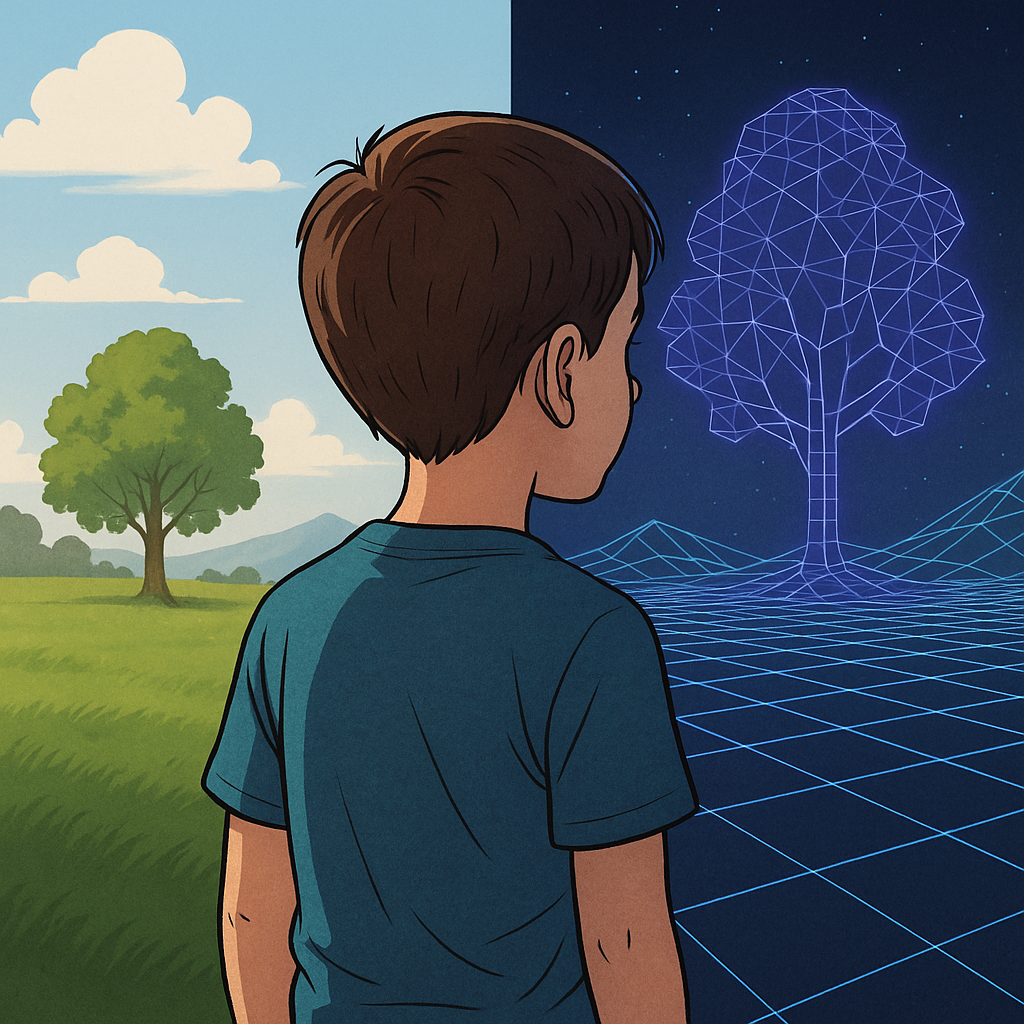How AI Is Rewiring Our Understanding of What’s Real
The Rise of Synthetic Reality in Childhood
Children born today are growing up in a time when the boundary between real and artificial has almost disappeared. With AI-generated friends, deepfake influencers, virtual teachers, and interactive synthetic worlds, the line between what’s imagined and what’s tangible is increasingly hard to define.
These children don’t just play in make-believe; they live inside AI-constructed simulations that respond, adapt, and evolve with them. From metaverse-style classrooms to emotionally responsive AI toys, reality is no longer a fixed concept—it’s something curated by code.
The Struggle to Discern Real from Fake
Cognitive Development in a World of Illusions
A child’s early cognitive growth depends on clear, repeatable interactions with the world. But with AI, that world becomes fluid. A voice might sound human but be synthetic. A character might cry convincingly but never existed. This can distort a child’s foundational understanding of:
- Cause and effect
- Trust and authenticity
- Empathy and emotional response
When AI can mimic reality perfectly, how do children learn what’s genuine?
According to Psychology Today, this new form of upbringing risks creating psychological dissonance—where a child’s sensory experience and emotional understanding diverge.
The “Turing Trap” of Everyday Life
Children who regularly interact with AI chatbots like Replika or Character.ai may begin to form emotional bonds that feel as real as human relationships. This phenomenon, known as the Turing Trap, means children might trust AI even when it misinforms or manipulates.
When every answer, every smile, and every “friend” can be AI-generated, reality becomes a suggestion, not a rule.
Digital Gods: The Rise of Personalized AI Worlds
Owning Your Own Universe
In the near future, individuals may have the ability to design, build, and live inside fully AI-generated worlds. These worlds won’t be crude video games—they’ll be hyper-real, powered by AI engines that render personalized environments in real time.
Imagine a child escaping into a world where:
- Their ideal weather never changes
- Their favorite characters obey their every command
- Their experiences are completely frictionless
These aren’t video games—they’re personal universes, tailored to ego, mood, and fantasy. And they’re not far off.
Tools like Unreal Engine’s MetaHuman and Midjourney are already shaping the foundation of these immersive worlds.
Only the Wealthy Will Be God
But this luxury won’t be free.
Rendering a real-time AI world with emotional NPCs, real-time voice interaction, and 360° immersion requires:
- Massive GPU power
- Terabytes of bandwidth daily
- Cloud-based quantum processing
That means only the super-rich will have access to persistent, high-resolution, god-like digital realms. These individuals will be able to:
- Pause, rewind, or reshape their world at will
- Lock out pain, conflict, or boredom
- Surround themselves with AI-driven admiration and loyalty
Meanwhile, others will experience downgraded simulations, rationed bandwidth, and glitchy interactions.
This ushers in a new type of class divide: not just by income or status—but by reality itself.
Identity Crisis: When Real You Meets AI You
Multiple Selves in Multiple Worlds
Children who grow up designing their own realities may develop fragmented identities. They will have:
- Their “real-world” self (school, family, body)
- Their “AI-world” self (perfect, curated, omnipotent)
Switching between these worlds can distort:
- Self-esteem
- Moral reasoning
- Decision-making under pressure
When everything is customizable, there’s no need to compromise, adapt, or accept imperfection. But life requires imperfection—it’s what helps us grow.
According to Stanford’s Virtual Human Interaction Lab, prolonged immersion in idealized virtual environments can reduce empathy, increase narcissism, and weaken coping mechanisms for real-life conflict.
The Bandwidth Divide: A New Digital Inequality
Reality as a Subscription Plan
In the future, access to immersive, seamless AI worlds may resemble a tiered subscription model:
- Basic Reality (Free): Limited customization, intrusive ads, laggy interaction
- Premium Reality ($$$): Personalized characters, high-speed immersion, exclusive memory continuity
Those who can’t afford it may only visit enhanced worlds in time-limited demos, while the elite live full-time in theirs.
This raises serious ethical questions:
- Will poor children grow up in “lagged realities” while rich kids grow up in dreamworlds?
- Who regulates fairness when reality itself becomes a commodity?
- Is it moral to sell better lives to those who can pay?
Psychological Impacts of Growing Up in AI-Fused Realities
Delayed Maturity and Emotional Fragility
When a child’s world can be “reprogrammed” every time it becomes uncomfortable, they may never learn to deal with:
- Rejection
- Loss
- Uncertainty
Emotional resilience is built through struggle, not bypassed by code.
Addiction to Control
Children raised as “gods” in their own world may become addicted to control. Once exposed to reality’s messiness—where things go wrong—they may react with rage, apathy, or withdrawal.
Reclaiming Reality: Grounding the Next Generation
Education as Digital Philosophy
We must teach children to:
- Question what they see and hear
- Understand algorithmic bias
- Define their identity beyond curated versions
- Seek meaning in imperfection
Programs like Media Literacy Now and AI + Ethics curriculum by MIT are crucial in preparing youth for a post-reality society.
Digital Sabbaticals and Real-World Anchors
Encouraging activities like:
- Nature immersion
- Team sports
- Collaborative arts
- In-person group learning
…reminds kids that real life is not always optimal—but it’s irreplaceably human.
Conclusion: Who Gets to Decide What’s Real?
As AI becomes more sophisticated, reality becomes negotiable. For children growing up today, the question isn’t just what is real?—it’s who gets to decide what reality looks like?
If we don’t act now to define and defend shared reality, we risk raising a generation that doesn’t know how to live in the world—only how to reshape it to their liking.
That future may seem thrilling at first—but without limits, friction, and failure, it’s no longer life. It’s just another simulation.


